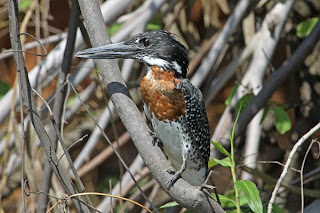So what finally prompted us to go to last night’s away fixture against S.L. Benfica? Well, you won’t be surprised to learn that there was a bird involved!
Mural in subway outside the Estádio da Luz
Benfica is definitely the biggest club in Portugal. Based in Lisbon, they play at the Estádio da Luz, an impressive stadium with a capacity of 65,647 that was built for the 2004 European Championship. So going to see and experience the stadium was one reason to go.
However, the clincher was probably the chance to see the Benfica mascot, a Bald Eagle named Águia Vitória that flies inside the stadium before each match and eventually lands on top of the club emblem. Not that we haven’t seen plenty of Bald Eagles before, you understand, but we had heard a lot about this tradition and thought it might be fun to go and see it.
The opportunity to go presented itself when we saw in the local newspaper that we could travel on a supporters’ coach from Olhão for 25 Euros, a price that included the match ticket as well as the coach fare! With the kick-off scheduled for 8.30pm, we were puzzled as to why the coach was leaving Olhão at noon for the 300km journey but that was the deal and we went along with it.
Unfortunately, as we headed north the weather worsened and by the time we crossed the Tejo river on the 25 de Abril Bridge, the city of Lisbon was shrouded in low cloud and it was raining. It continued to rain all evening.
Across the road from the Estádio da Luz is the Colombo Shopping Centre, one of the largest malls in Europe. Maybe that’s why we arrived at the ground four hours before the kick-off. Maybe the Olhanense fans were treating this as a Christmas shopping trip! Anyway, it was somewhere we could get a bite to eat and importantly stay out of the rain.
We entered the stadium as soon as it was open and after some fairly stringent security and a steep climb to the third tier of the stand, we quickly found our seats. One description of the stadium that we have read refers to its polycarbonate roof allowing the Sun's rays to penetrate it, lighting the stadium. Unfortunately, we were there on a Saturday evening, long after the Sun had disappeared and the roof was also being penetrated by heavy rain! Away fans everywhere seem to draw the short straw!
The match itself was fairly uninspiring. The first half was played almost exclusively in one half of the pitch with Benfica creating quite a few scoring opportunities but managing only a single goal in the 26th minute via a fairly 'soft' penalty taken by Oscar Cardozo. Olhanense did show a bit more ambition during the second half but seldom really looked likely to equalise. They conceded a second goal in the 72nd minute from a Luisão header that bounced before going over the visiting goalkeeper. The attendance was reported to be 24,107 but the crowd was quiet and we were surprised that there were so many – it was difficult to judge with people scattered about in the huge stadium.
Our view from behind netting at the Estádio da Luz
There were probably no more than a couple of hundred Olhanense fans and they made very little noise at all. It seems that, much like their team, they had showed up at Benfica resigned to the fact that they were going to lose and on a miserable, wet night they weren’t going to get too worked up about it. In fact, there was much more noise from them on the coach than there was during the match.
We arrived home at 3.30am, still drying out, but at least we had seen the Benfica eagle! All this was on a day when June’s first love, West Bromwich Albion, scored a great win at the other Stadium of Light in Sunderand taking them to third place in the Premier League.























